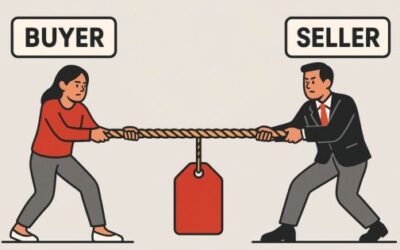Getting your prospect engaged, getting them on the proverbial hook is critical to selling. Prospecting is the holy grail of sales and it get’s a lot of attention as it should. To most of us, finding and hooking the fish feels like the hardest part. The problem is, prospecting is just the beginning and too often we don’t spend as much time thinking about how we’re going to close or win the deal (land the fish)– and that’s where deal strategy comes in.
Prospecting Vs. Deal Strategy: Where Should I Focus?
Run a search under “deal strategy” and you get 116,000 hits. Run a search under “sales prospecting” and you get 1,410,000 hits. That’s 12x more hits for prospecting than deal strategy. Prospecting gets 12x more of our attention than deal strategy, yet deal strategy is arguably more valuable than prospecting.
Finding the bar where all the hot people hang out is fairly easy, actually meeting someone and then getting them to agree to go on a date? Well, that’s an entirely different story — that takes strategy.
Building a pipeline of qualified opportunities is critical, but opportunities don’t pay the bills. Those opportunities need to be closed and I can tell you, they ain’t gittin’ closed without solid deal strategies.
What is Deal Strategy?
Deal strategy is “HOW” you’re going to move the deal from early opportunity stage to a closed deal and every deal strategy is custom for every opportunity in the pipeline. Deal strategies take into consideration the following;
- the stakeholders
- the objections and challenges
- the goals and objectives
- the competition
- your value proposition
- their current state and the desired future state
Critical Elements of Deal Strategy
The Stakeholders
A killer strategy starts with understanding ALL the stakeholders, their role in the sale, their personal objectives and biases and their ability to influence the sale. At the end of the day, it’s people who make the decision, not facts or ideology, or data, but people. If you don’t or can’t influence the right people, in the right way, nothing else matters. If you want to have a killer deal strategy, you’d better know the people landscape. It’s that simple.
The Objections and Challenges
Every deal right out of the gate, even the most aligned, has a number of challenges and objections. Understanding what they are, how they affect your buyer and all the other stakeholders is imperative. Take the time to understand what the root cause of the objections are, why do they exist? What is causing them to be a concern or challenge? Understanding is the goal here. The more you can understand what is behind the the buyers/companies objections AND challenges, the better positioned you will be to develop a plan that can address their specific situation.
Goals and Objectives
Like objections and challenges, this is an understanding game. It’s key to understand what the goals and objectives of the buyer and the other stakeholders are. What is it they are trying to get done and why? How will they measure success? What do they want to get accomplished.
The key here is to understand the goals and objectives at multiple layers. Do they want to increase inventory velocity (layer 1), in order to save money (layer 2), in order to increase net profits (layer 3) because they are putting themselves on the market and need a good P&L and Balance Sheet (layer 4) or are they looking to become more social (layer 1), in order to create more customer engagement (layer 2), so they can reduce their traditional add spend (layer 3) so they can put that money towards direct sales (layer 4) because they want to go after 35 new logo’s in 2014 (layer 5).
What matter most here is there is a clear understanding of exactly what it is the buyer and the stakeholders are looking to accomplish and why. This way your deal strategy will align with them achieving their goals and objectives.
The Competition
Ah, the competition! The pesky competition. Knowing who the competition is, how they will position their product or service, and how or your product stacks up against them and their offering can make or break a deal strategy.
Too often, the competition isn’t factored into the deal strategy and this can be catastrophic. Knowing if the competition will try to compete on price, on features, on relationships, etc., will drive the development of a good deal strategy. If they are going to try and compete on price, how will you battle that? If they will compete on features you don’t have, how will you counter? Knowing where the competition stands and how they will go to battle is extremely important to a solid deal strategy. Don’t ignore them, else they sneak up and bite you in the ass.
Your Value Proposition
This may seem like a simple element or like a “duh?” But it’s not. A deal strategy is heavily dependent on a clearly articulated, substantial value proposition. Your value proposition is your secret weapon as you go into battle and like most weapons, you have to use it appropriately. If you’re secret weapon is a “long bow” engaging in close quarters battle is a suicide mission.
Clearly articulated, robust value propositions act as the foundation to winning deal strategies. Know what your value proposition(s) are, how they bolster your deal strategy, how they impact the stakeholders, and keep out the competition. Hint: no two “value propositions will be completely alike. Every customer will have their own unique value proposition based on their unique problems, goals, objectives etc.
Current State vs Future State
This is an interesting part of the deal strategy. It overlaps with goals and objectives and challenges and objections. However, it is different. Using current state and future state in your deal strategy is like the marketing wrapper. It’s what you wrap your deal strategy in. At the end of the day, your buyer/prospect is looking to change. A sale can not be made without a desire to change.
Change is at the core. Therefore, creating a vision of what the change will look like and how it will positively affect your buyer/prospect can be a power element of the deal strategy. By developing a deal strategy that highlights and promotes a future state ONLY YOU can provide that is the panacea of future states your buyer/prospect is anchored in a vision that pulls them through the sales cycle.
Current state/future state is the wrapping, it’s the dressing, that makes everything look pretty. A solid deal strategy helps anchor the client in the FACT that their current environment is not good for them and isn’t aligned with their goals and objectives. It anchors the sale in a negative state, thereby increasing the desire to move. It then shifts the focus on to a new, improved future state where life is far better and the goals and objectives are being achieved. Embedding a powerful vision of a future state only you and your company can provide should be woven into any and every deal strategy.
Improve Your Close Rates
Winning a deal without a solid deal strategy is hard. Customers will cling to the status quo. The competition is looking to eat you alive. Outside forces, such as the economy, are ever looming, waiting to pounce and throw a wrench into all your hard work. A lot of time is spent on prospecting, trying to find opportunities, don’t waste them because the right deal strategy isn’t in place.
For every opportunity there needs to be a solid deal strategy. Every sales manager needs to ask their reps at every pipeline meeting, “what is the deal strategy?” Don’t let a deal move forward without one. Deals will get away from you if you don’t. Be deliberate in how you go after every opportunity. Be proactive and prescriptive, it’s the best way to win. (Being prescriptive doesn’t mean being rigid. Expect to tweak your strategy constantly. Deal strategies are NOT static and will change as new information surfaces, new player emerge, the competition pivots and customer needs shift).
They don’t get much air time. They’re not seen as sexy. Few “sales guru’s” talk about them, but you can bet your ass they are one of the most important elements to winning deals and making quota.
If you want to win more deals, keep prospecting like crazy, ’cause it’s important, but shore up the other side of the equation. Have solid deal strategies with EVERY deal you’re chasing, then watch your closing ratio go through the roof. Deal strategies are legit. Like most things, you can be deliberate or reactive. I’ll let you tell me which you think works best.
If you or your sales team needs help improving your deal strategy reach out to our sales team to learn more.
HOW TO BE MORE BUYER-CENTRIC in your discoveries. Pro Tip: To stop getting yourself trapped in low value discoveries, do this. It will change the game!





0 Comments